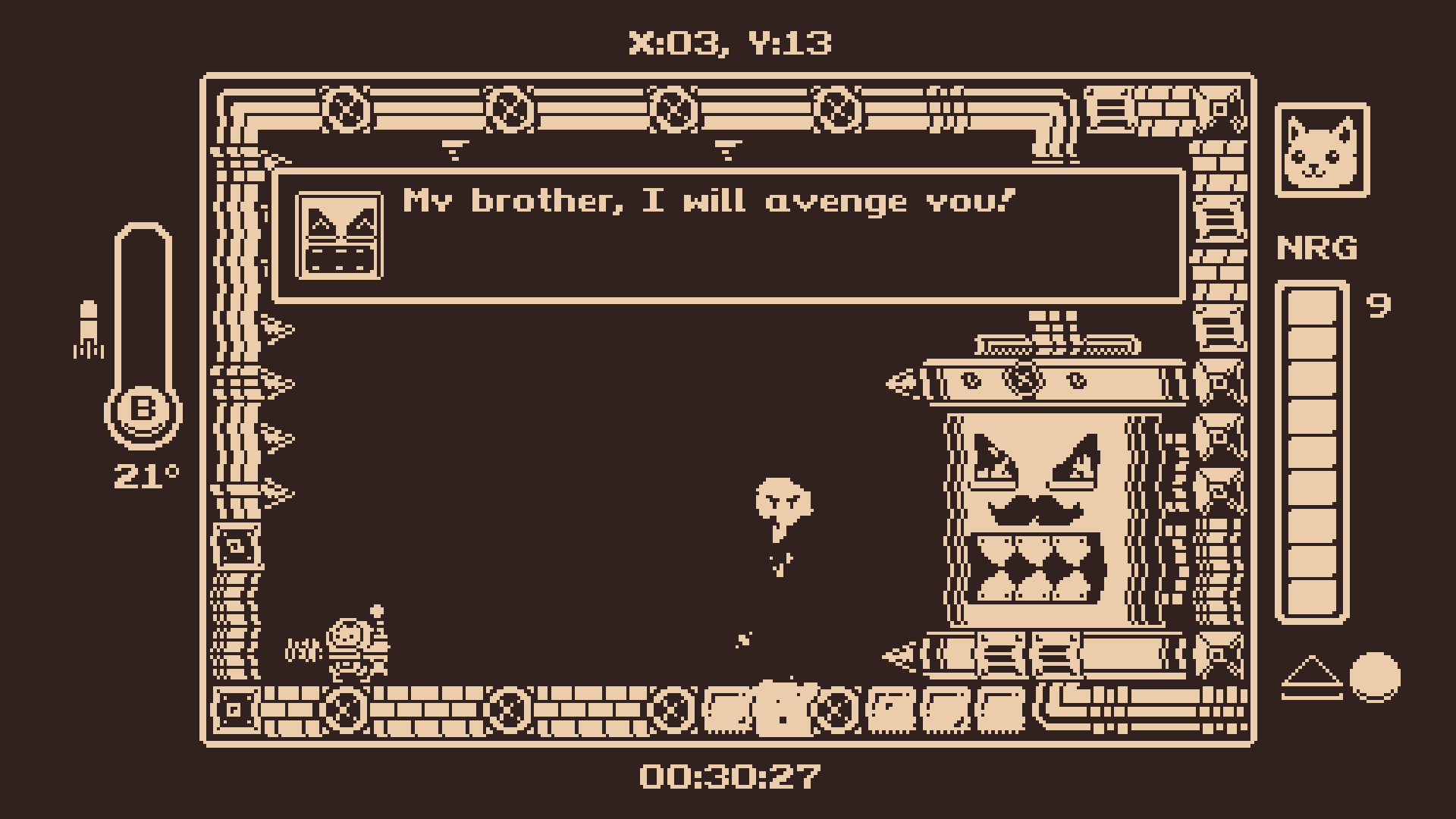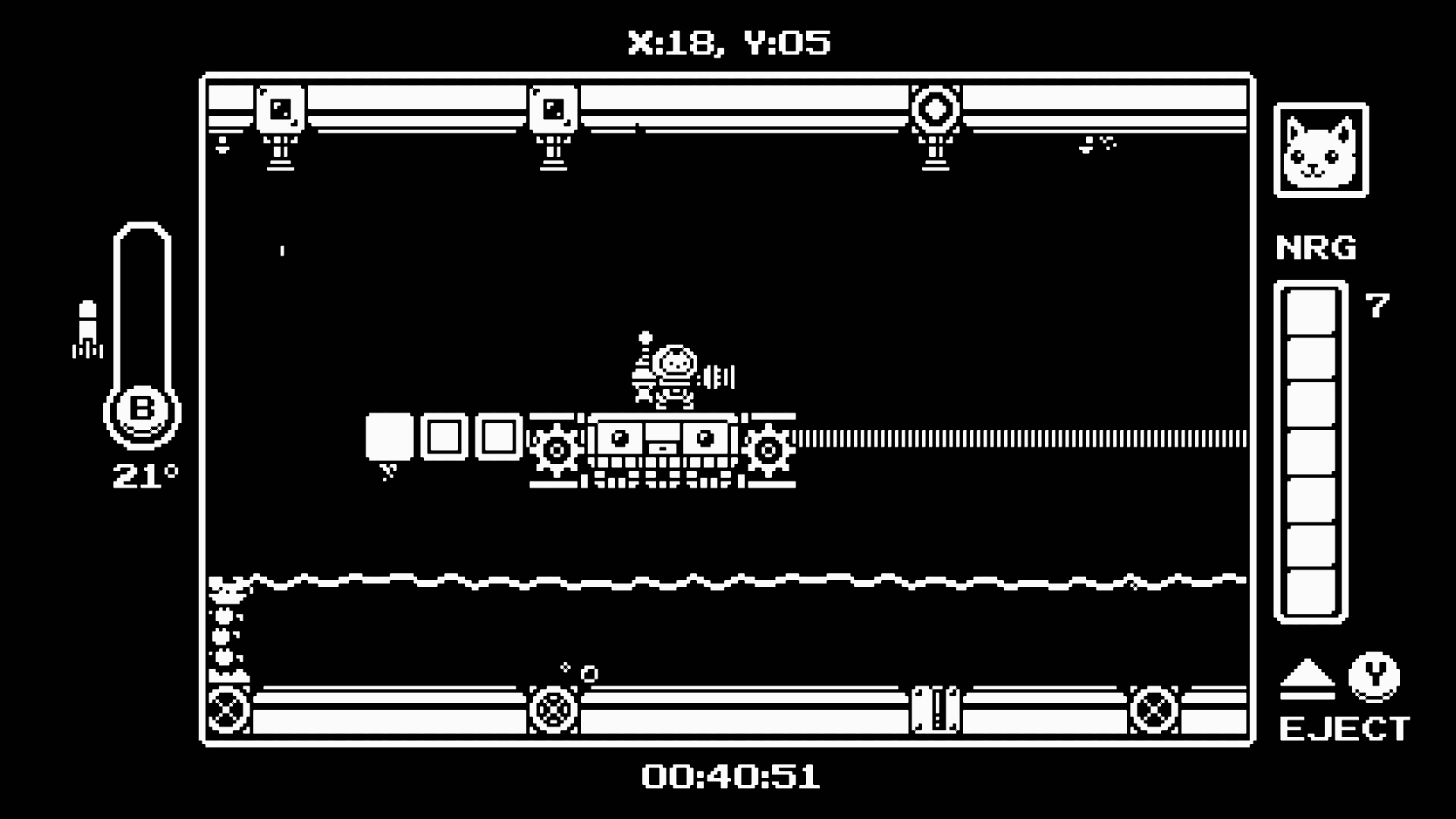Why reinvent the wheel?
Gato Roboto Review
Published on .
| Developer | doinksoft |
|---|---|
| Publisher | Devolver Digital |
| Release year |
Calling Gato Roboto a Metroidvania feels like too broad of a statement. No, Gato Roboto is a Metroid game in all but name. From structure to gameplay, it is Nintendo’s bounty hunter series through and through. But that’s not to say that the game is a shameless ripoff—quite the contrary. Gato Roboto respects its roots, extends them slightly, and puts its own spin on them.
The game’s story follows ship commander Gary and his cat Kiki. After receiving a distress call, they follow it to a foreign planet. But, unfortunately, they arrive there by crash landing. With Gary trapped in the ship, it falls onto Kiki to figure things out in these new surroundings. And they rise to the occasion in a game that feels oddly familiar.
It’s Metroid
Gato Roboto doesn’t hide its influences at all. It doesn’t get more clear than a 2D side-scrolling platforming action-adventure which you navigate in a suit. A suit which shoots beams and missiles. Further, the saving stations look very similar to those introduced in Super Metroid. And one of the suit upgrades is literally called the Spin Jump. So yeah, it’s an open-and-shut case where the inspiration for this game came from.
Structurally, Gato Roboto cribs from several Metroid games. The central hub from which all other regions can be reached via elevator is reminiscent of Metroid Fusion. The challenging gauntlet leading up to the final fight screams Tourian. And the one sector built around playing without the protective suit is a nice Zero Mission reference.
Until it isn’t
Sure, the game doesn’t hide its strong Metroid influences, but it brings its own flavour to the familiar.
If there were one adjective I wouldn’t use to describe Metroid, it would be cute. But with Gato Roboto, it’s totally different.
I mean, you play as a cat! What more is there to say?
Another unique thing this game has going for it, among the Metroids, is its silly humour.
There are the simple things, like the planet coordinates being 42069, but some are more elaborate.
In the hot sector, Kiki has to disable two heaters.
Thing is, they are both lively characters who are also brothers.
One of them has a moustache.
These things give Gato Roboto a unique and playful atmosphere.

What differentiates Gato Roboto isn’t purely aesthetic, though. How are things different gameplay-wise?
Saving is a big deal in Metroid since it’s back to the last checkpoint on death. For this game, the process is satisfyingly instantaneous. What takes several seconds in, for example, Super Metroid, takes a second here tops. Also, in Metroid, these save stations are usually in a dedicated room to the side, but here they are directly integrated into your route through the sector.
The combat has some interesting differences as well.
While Gato Roboto has the familiar beam/missiles split, missiles are handled differently from all other 2D Metroids.
First of all, in this game missiles come in infinite supply.
But you can only shoot a few missiles in quick succession before your rocket arm overheats and has to cool for a few seconds.
On top of that, shooting missiles has noticeable recoil that pushes Kiki back slightly, so shooting missiles has to enter into your movement calculus.
Thus it’s not always appropriate to use it to its full extent unless you want to constantly ram your back into enemies.
Overall, I like this beam–missile tradeoff more than the traditional Metroid one, where your uncharged beam is weaker, but missiles are finite.
Here, choosing between beam and missiles impacts your movement, and only your beam remains usable when your arm is cooling off.
This makes for much more interesting choices during combat because everything has an immediate consequence you have to anticipate and react to.
Further, enemies do not drop health in this game.
The only way of replenishing your suit’s energy is by saving.
Fortunately, save points are liberally scattered across the planet.
Combined with missiles coming in infinite supply, Gato Roboto eliminates resource grinding entirely!
Master of tradeoffs
Mechanical tradeoffs are at the centre of Gato Roboto’s design philosophy, and the distinction between beam and missiles is only the start.
Let’s examine Gato Roboto’s tradeoff design with one example: the suit.
The core tradeoff of this game’s gameplay is the mech suit.
In Metroid, when encountering a narrow passage, it’s time to minimise Samus into the Morphball.
No such thing exists in this game.
To make yourself small again, you have to exit the suit instead.
So when you get to a narrow passage through which the suit cannot go, you have to leave behind its safety to pass.
This game’s version of the Morphball is much more exciting than it usually is.
Without a suit, Kiki is very acrobatic, allowing them to dash up walls, whereas in the suit you can only jump to a set height.
Going zero-suit is required more often than you might like, but in turn, it creates tense moments with an emphasis on movement because misstepping into an enemy kills you instantly.
The game knows this and so, as previously mentioned, there’s an entire sector built around playing without a suit.
And on top of all of this, the suit isn’t waterproof.
So you have to do similar things when encountering a body of water and often worry about how to get the suit across.
The last thing I want to praise about this suit is how well the developers understand how to make it feel weighty. Again, it is done by utilising the contrast with the suit on and off. Kiki without a suit has a very slight slippery feel to them. When running at full speed it takes them a split second to wind down and come to a halt. This slipperiness is subtle enough, that you won’t consciously notice. But it is pronounced enough to notice the contrast with the suit, where you stop immediately on releasing the directional button. This attention to detail is what makes this game truly special.
Black and white
The most immediately striking thing about Gato Roboto are its beautiful bitonal monochrome visuals. That is, images of this game are only composed of two colours. Levels feature lovely details with animated background sprites, foliage that reacts to you passing by, bubbling water, and water dripping down from pipes. It’s a true love letter to Game Boy graphics and shows what can be done with these visual limitations on modern hardware. And in true Game Boy Color fashion, the game can be played in various colour pallets. Individual pallets are collectable rewards in the same way that health upgrades are, which is a smart way of rewarding exploration. Gato Roboto is a short experience, so having more extensible game systems would probably feel more like a hindrance than conveying a feeling of getting stronger.
As striking and unique as Gato Roboto is, its aesthetic comes with some unfortunate downsides. Flashing light is regularly used to accentuate actions in scenes. When skipping cutscenes, their playback is accelerated which sometimes leads to multiple flashes in quick succession. Such flashing effects—of either sprites or the entire screen—are common in Game Boy games. Usually, I would commend the game on its dedication to this specific aesthetic. But there is a crucial difference here: the original Game Boy has no backlighting, but all modern displays do. Luckily the flashing doesn’t appear to be frequent enough to trigger seizures for those with photosensitive epilepsy. Ofcom, the UK’s broadcasting regulator, says in their Guidance Notes: Section 2 - Annex 1: ‘isolated single, double, or triple flashes are acceptable’. And that is exactly the flashing pattern you will find in Gato Roboto. But while not drastically harmful, I still find repeated flashing of the screen quite offensive to the eyes. Which is a shame for a game with such an otherwise pleasant aesthetic.
The strong adherence to the bitonal monochrome graphics also has some negative implications for the level design because there is no clear separation between foreground and background. One might wrongly assume that everything that shares the colour that makes up Kiki is in the foreground, and the other colour is the background. To illustrate the problem, take a look at this screenshot.

What might appear as striped, solid ground are actually rails for the platform Kiki is standing on. The rails have no collision. What happened to me when first encountering this element was that I jumped, and counter to my expectations fell through. I imagine that I’m not the only one who had this problem. There is an easy fix for this: make the rails slightly transparent. In fact, the Game Boy’s monochrome display supports different shades of the same colour. But clearly, the creators didn’t want to compromise on their limited aesthetic. The game does try communicating what is going on by placing leaky pipes above the rails so you can see the droplets falling through, but such a small detail is easily overlooked when platforming.
Conclusion
Gato Roboto is a cute game with a striking aesthetic.
The Metroid-style gameplay and level design are perfectly adapted for this small experience.
It leaves you with a simple core of what we love about these games and doesn’t overstay its welcome.
However, the rigid adherence to the bitonal monochrome art style has some clear downsides.
Sticking by the rigid rules of the aesthetic is an impressive creative limitation, but I still feel like light compromises could have further improved this otherwise excellent experience.